Wood Stove
How To Clean Wood Stove Glass Door

Cleaning the glass door on a wood-burning stove might feel like a daunting task, but fear not! I’ve got the ultimate guide right here to help you make those doors shine in no time.
With just a few simple steps, you’ll be able to remove stubborn grime and restore your glass to its former glory.
So grab your supplies and get ready to tackle that dirty glass like a pro. Trust me, you won’t believe the difference it makes!
Key Takeaways
- Effective cleaning techniques include using a vinegar and water solution, baking soda paste, and lemon juice and salt scrub, and scrubbing the glass with a non-abrasive brush or sponge.
- Cleaning wood stove glass without harsh chemicals can be done using a vinegar and water solution, baking soda paste, and lemon juice and salt scrub, which are safer for health and the environment.
- Alternative cleaning tools for cleaning wood stove glass include mixing vinegar and water, using a baking soda paste, using newspaper, and using a non-abrasive brush or sponge.
- After cleaning the wood stove glass, it is important to rinse off the cleaning solution using a clean damp cloth or sponge, wipe in circular motions, inspect for remaining stains or spots, and repeat the cleaning process if needed.
Gather the Necessary Supplies
I’ll need a damp cloth, vinegar, and newspaper to clean the wood stove glass door.

Cleaning the glass door of a wood stove can be a bit tricky, but with the right techniques and supplies, it can be done effectively.
When it comes to glass cleaning techniques, it’s important to use methods that are safe for the environment and eco-friendly. One of the best options is to use vinegar, which is a natural cleaning agent that’s both effective and environmentally friendly.
To begin, I dampen a cloth with water and wring out any excess moisture. This ensures that the cloth is just damp enough to clean the glass without leaving streaks.
Next, I spray some vinegar onto the damp cloth. Vinegar is known for its ability to dissolve grease and grime, making it perfect for removing any residue on the glass door. I gently wipe the glass in circular motions, applying a bit of pressure to remove any stubborn stains.
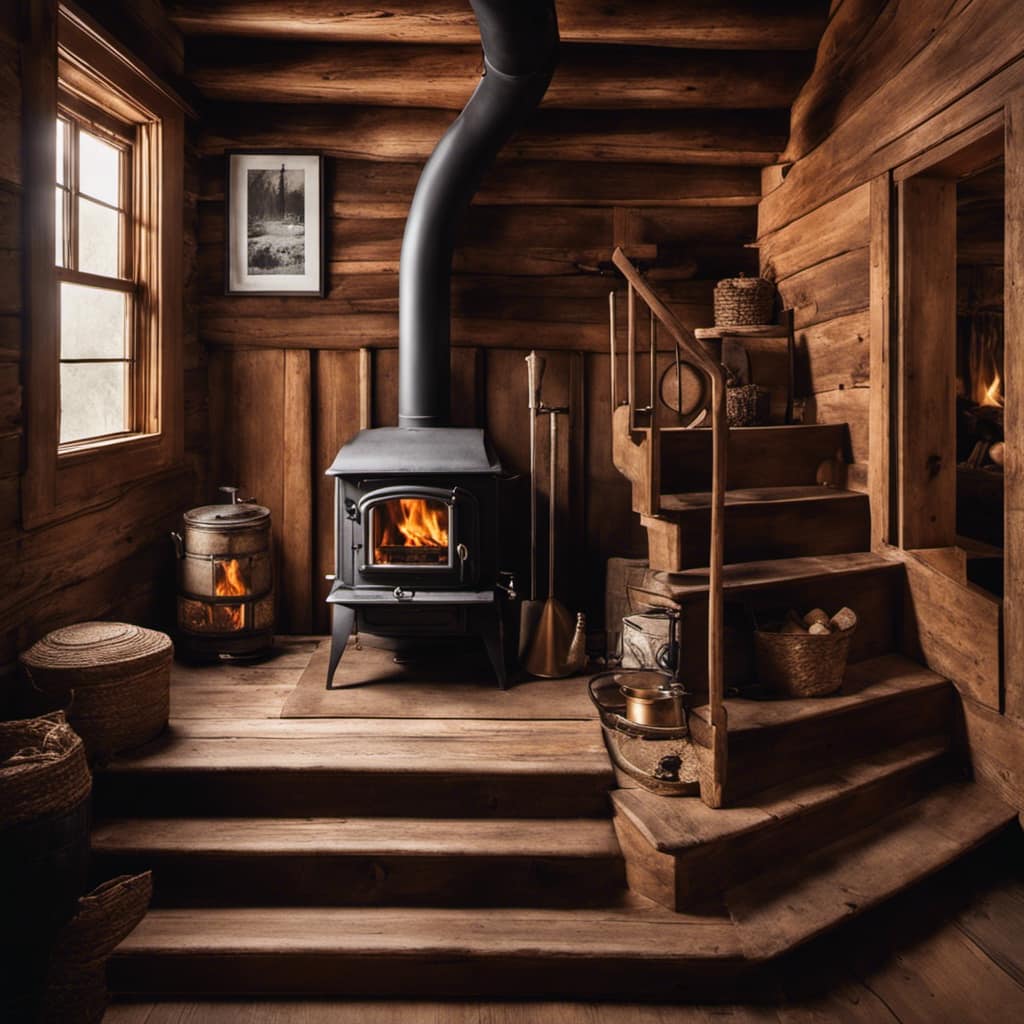
Once the glass is clean, I use a dry newspaper to buff the surface and remove any remaining streaks. Newspaper works well because it doesn’t leave lint or residue behind, leaving the glass door sparkling clean. It’s important to use a newspaper that doesn’t have colored ink, as this can leave smudges on the glass.
Remove Any Excess Ash or Debris
Before starting the process of cleaning the wood stove glass door, it’s important to remove any excess ash or debris that may have accumulated. I’ve found that using a small handheld brush or a vacuum cleaner with a brush attachment works well for this task.
Make sure to be thorough in removing all the ash and debris, as it can hinder the effectiveness of the cleaning process.
Ash Removal Methods
To remove ash from the wood stove glass door, I can use a damp cloth or a vacuum cleaner with a brush attachment. These ash removal techniques are essential for proper glass door maintenance.
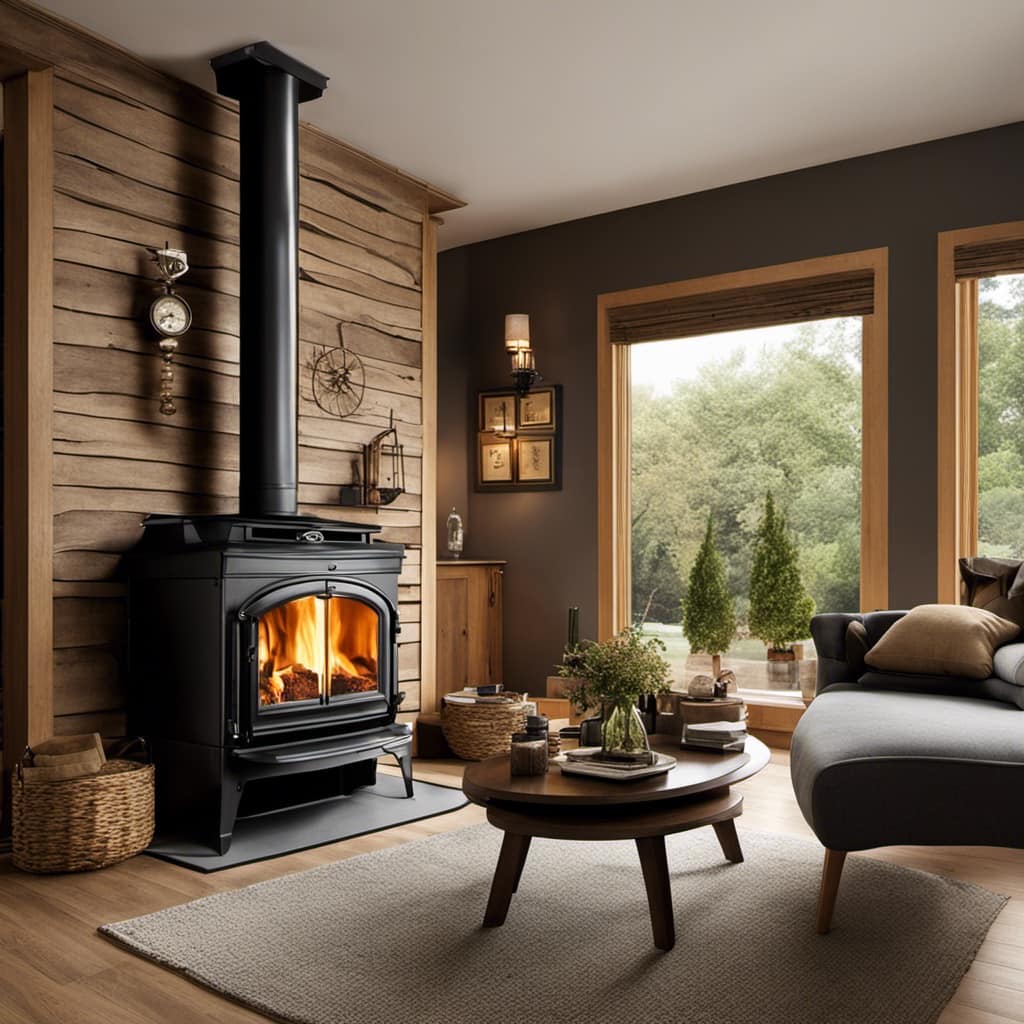
When using a damp cloth, I make sure it isn’t dripping wet to prevent water from damaging the glass or the stove. I gently wipe the glass in a circular motion, ensuring that all the ash is removed. If there’s a stubborn residue, I can also use a glass cleaner specifically designed for wood stoves.
Alternatively, using a vacuum cleaner with a brush attachment is another effective method. I carefully vacuum the ash off the glass, making sure not to scratch it.
Regular ash removal is crucial to keep the glass door clean and to maintain optimal visibility of the fire.
Debris Disposal Techniques
When disposing of debris, I make sure to safely remove it from the area around the wood stove. Proper debris disposal techniques are crucial to maintain a clean and safe environment. Here are some effective methods I use:
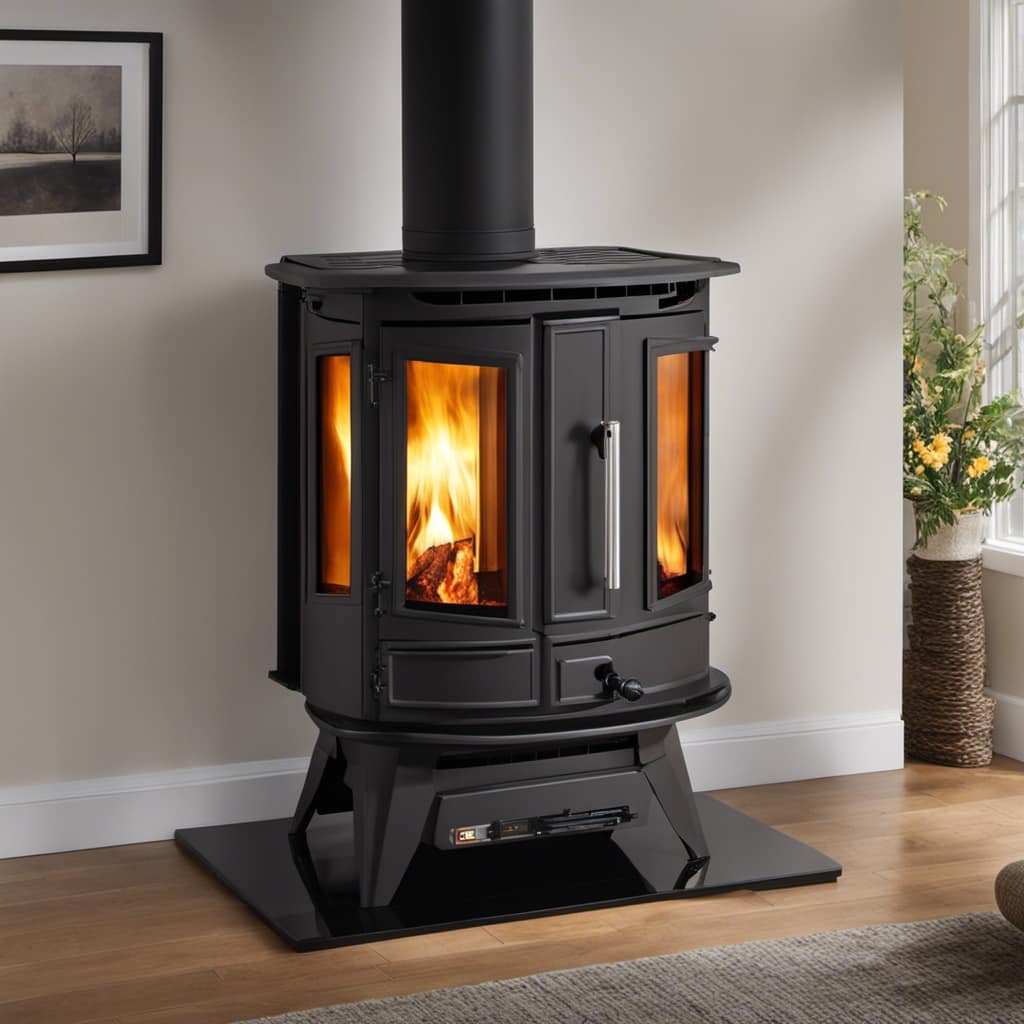
- Use a shovel or a dustpan to carefully collect the debris and ashes.
- Transfer the collected debris into a metal bucket or a fireproof container for safe storage.
- Dispose of the debris in a designated outdoor area away from flammable materials, such as dry leaves or wooden structures.
By following these techniques, you can prevent accidents and minimize the risk of fire hazards.
Additionally, it’s important to regularly clean the glass door of the wood stove to maintain its efficiency and aesthetic appeal. Stay tuned for the next subtopic, where I’ll share some effective glass cleaning techniques.
Glass Cleaning Solutions
I always find it helpful to use a mixture of vinegar and water to remove any smudges or fingerprints from the glass surface. This natural glass cleaning solution is not only effective but also safe for the environment. To further assist you in finding the best glass cleaning technique for your needs, I have created a table below that compares the effectiveness, ease of use, and cost of different glass cleaning solutions:
| Glass Cleaning Solution | Effectiveness | Ease of Use | Cost |
|---|---|---|---|
| Vinegar and Water | High | Easy | Low |
| Commercial Glass Cleaner | High | Easy | Medium |
| Lemon Juice | Moderate | Moderate | Low |
As an experienced cleaner, I can confidently say that using vinegar and water is a reliable and cost-effective way to keep your glass surfaces spotless. Give it a try and see the difference for yourself!

Mix a Cleaning Solution
I’ll start by mixing a cleaning solution for the wood stove glass door. Cleaning the glass door of a wood stove is essential to maintain its efficiency and appearance. Over time, soot and dirt can accumulate on the glass, making it difficult to see the fire inside. Fortunately, there are several cleaning techniques and alternative cleaning methods that can effectively remove grime and restore the glass to its original clarity.
Here are some alternative cleaning methods for wood stove glass doors:
-
Vinegar and water solution: Mix equal parts white vinegar and water in a spray bottle. Spray the solution onto the glass and let it sit for a few minutes. Then, wipe the glass with a soft cloth or sponge. The acidity of the vinegar helps to dissolve and remove the soot and dirt.
-
Baking soda paste: Make a paste by mixing baking soda with a small amount of water. Apply the paste to the glass using a cloth or sponge. Gently scrub the glass in circular motions, focusing on areas with stubborn stains. Rinse the glass with water and wipe it clean.
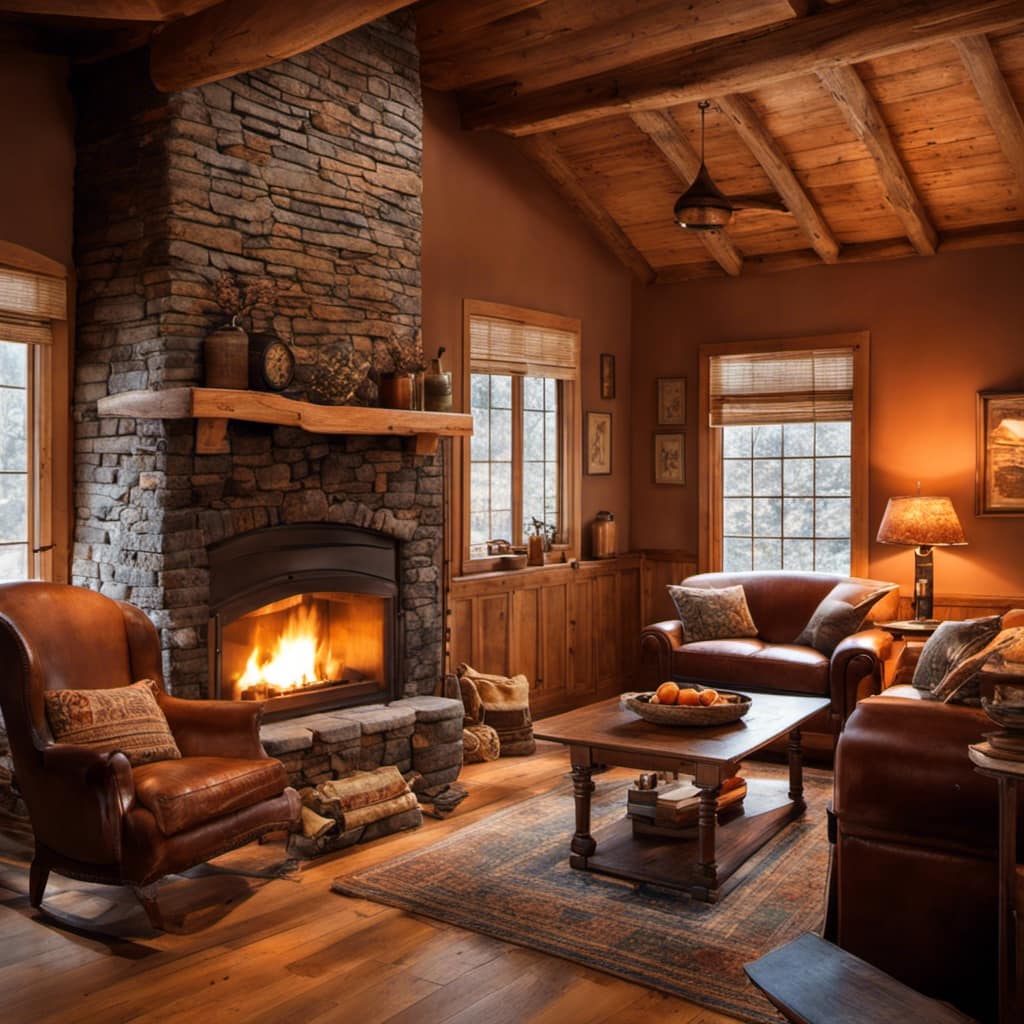
-
Commercial glass cleaner: If you prefer a ready-to-use solution, there are commercial glass cleaners available specifically designed for wood stove glass doors. Follow the instructions on the product label for best results.
Apply the Cleaning Solution to the Glass
Now that we’ve our cleaning solution ready, it’s time to apply it to the glass.
I recommend using a clean, lint-free cloth or sponge to evenly distribute the solution across the surface.
Start from the top and work your way down, applying gentle pressure to remove any dirt or grime.

Best Cleaning Solutions
Using a mixture of vinegar and water is the best solution for cleaning wood stove glass doors. I’ve found this to be the most effective method after years of experience cleaning my own wood stove. Here are the reasons why it’s the best cleaning solution:
- Vinegar is a natural cleaning alternative that’s safe to use on glass surfaces.
- The acidity of vinegar helps to break down and remove stubborn stains and residue.
- Water dilutes the vinegar, making it a gentle solution that won’t damage the glass.
When it comes to cleaning wood stove glass doors, it’s important to use the best cleaning tools and natural cleaning alternatives. The vinegar and water solution meets both of these requirements, making it the ideal choice for keeping your wood stove glass doors clean and clear.
Preventing Streaks and Smudges
To avoid streaks and smudges on my wood stove glass doors, I always make sure to wipe them dry with a microfiber cloth after using the vinegar and water solution. This simple step ensures that the glass is left crystal clear and free from any residue.
In my experience, this is one of the most effective cleaning techniques for preventing streaks on wood stove glass doors. The combination of vinegar and water cuts through the grime and leaves the glass looking spotless. By wiping it dry with a microfiber cloth, I eliminate any excess moisture that could potentially cause streaks.

This technique has consistently provided me with streak-free results, making my wood stove glass doors look clean and inviting. However, if you prefer cleaning without harsh chemicals, there are alternative methods that can be just as effective.
Cleaning Without Harsh Chemicals
I find that using natural ingredients is a great alternative for keeping my stove glass doors looking spotless. Not only are they effective in removing dirt and grime, but they’re also safer for my health and the environment. Here are three alternative cleaning methods using natural ingredients that I highly recommend:
-
Vinegar and Water Solution:
-
Mix equal parts of white vinegar and water in a spray bottle.

-
Spray the solution onto the glass doors and let it sit for a few minutes.
-
Wipe clean with a microfiber cloth or newspaper for a streak-free finish.
-
Baking Soda Paste:
-
Make a paste by mixing baking soda with water.
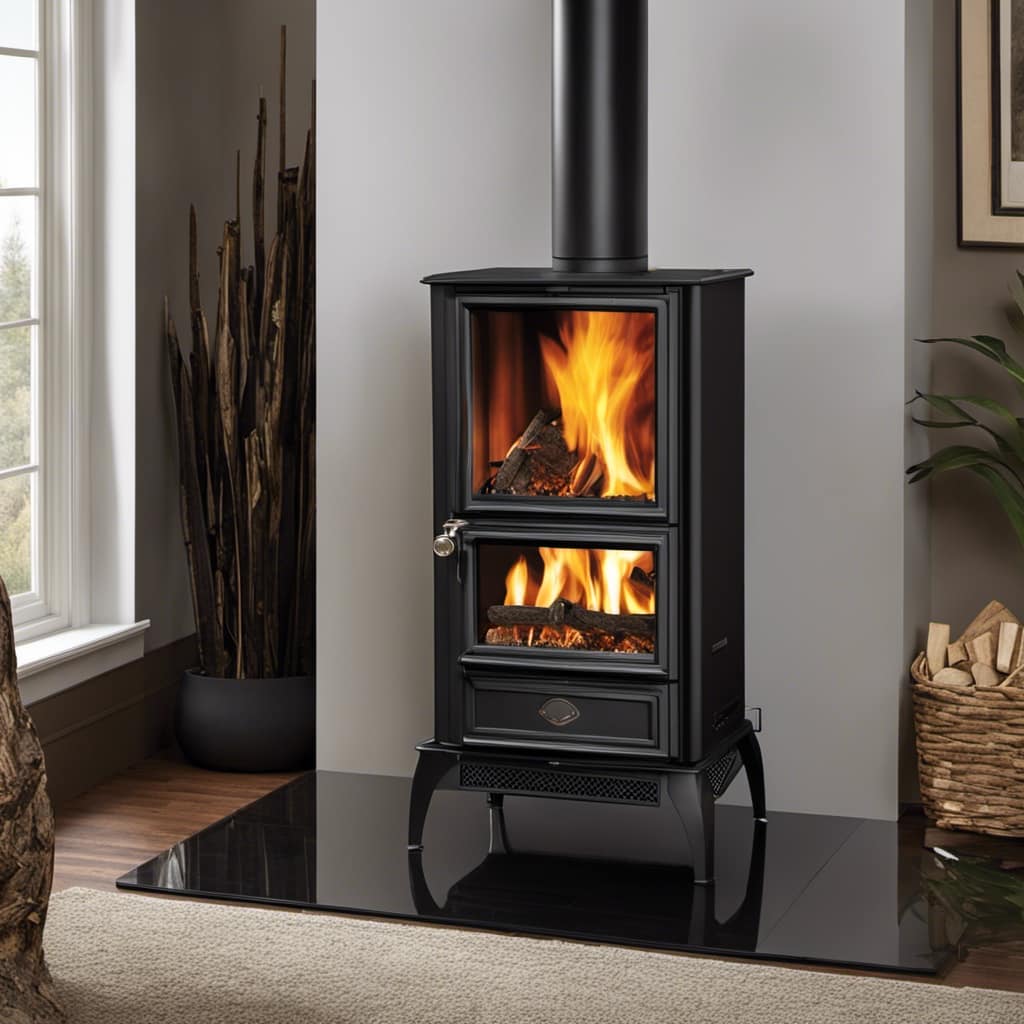
-
Apply the paste to the glass doors and scrub gently with a sponge or scrub brush.
-
Rinse with water and dry with a clean cloth.
-
Lemon Juice and Salt Scrub:
-
Squeeze fresh lemon juice onto the glass doors.

-
Sprinkle salt on top and use a sponge to scrub the surface.
-
Rinse with water and wipe dry for a shiny, clean result.
Let the Solution Sit for a Few Minutes
After applying the solution, I let it sit for a few minutes to allow it to work its magic on the wood stove glass door. By allowing the solution to sit for a few minutes, it gives it enough time to penetrate and loosen the grime and soot buildup on the glass. This step is crucial for achieving the best results. During this time, the solution breaks down the dirt and makes it easier to remove.
Once the solution has had enough time to work its magic, it’s time to move on to the next step. Using a non-abrasive brush or sponge, I gently scrub the glass in circular motions. This helps to further loosen any stubborn residue and ensure a thorough cleaning. The non-abrasive nature of the brush or sponge prevents scratching or damaging the glass surface.
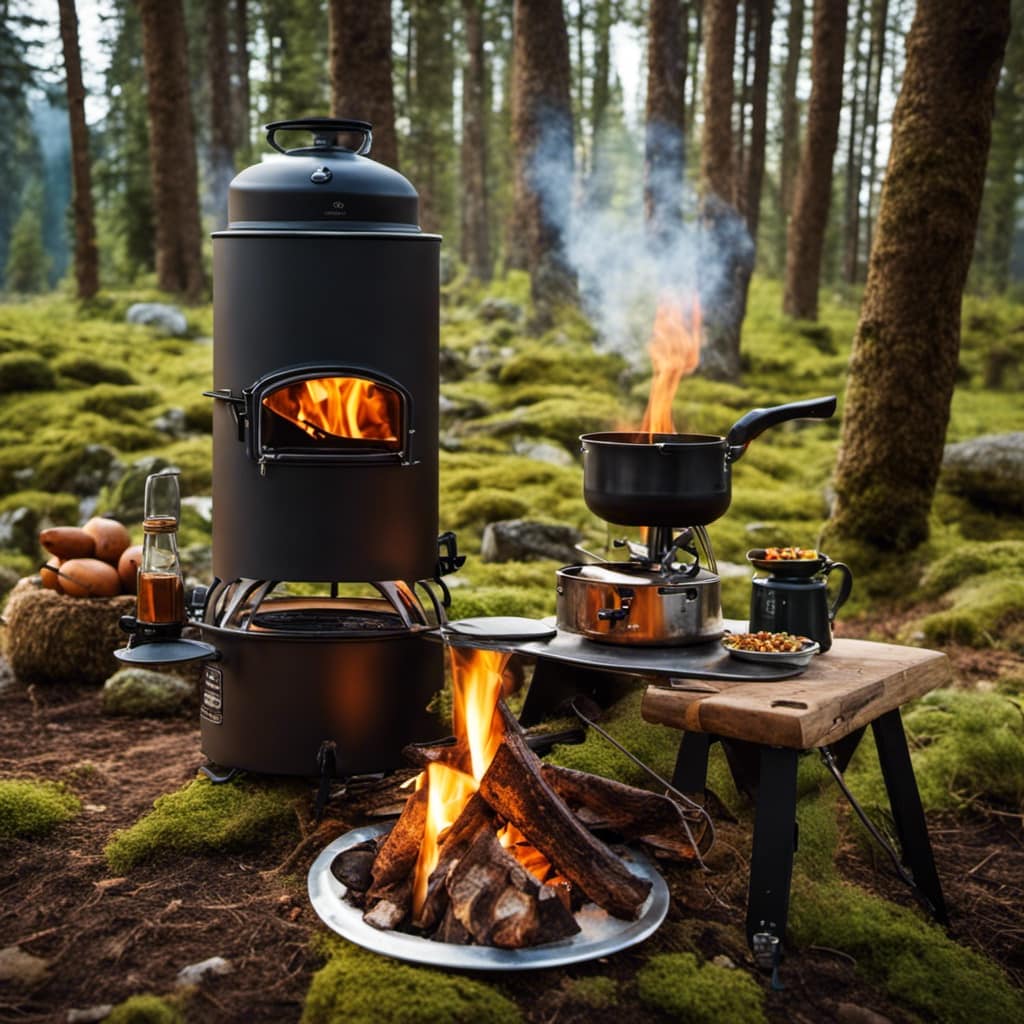
When it comes to cleaning a wood stove glass door, it’s important to use the best cleaning methods and alternative cleaning solutions that are effective yet gentle on the glass. Harsh chemicals can’t only damage the glass but also release toxic fumes when heated. That’s why I prefer using natural solutions that are safe and environmentally friendly.
Scrub the Glass With a Non-Abrasive Brush or Sponge
Using a non-abrasive brush or sponge, I can gently scrub the surface and remove any remaining residue. This step is crucial when it comes to cleaning the glass on a wood stove door. Over time, soot and ash can build up, making it difficult to see the fire inside. By using the right technique and tools, you can restore the glass to its original clarity.
Here are some glass cleaning techniques and alternative cleaning tools that I’ve found to be effective:
-
Mix vinegar and water: Vinegar is a natural cleaning agent that can help break down the soot and grime on the glass. Mix equal parts vinegar and water in a spray bottle and apply it to the glass. Let it sit for a few minutes before scrubbing.

-
Baking soda paste: Create a paste by mixing baking soda with a small amount of water. Apply the paste to the glass and let it sit for a few minutes. Then, use the non-abrasive brush or sponge to scrub the glass in a circular motion.
-
Use newspaper: Instead of using a traditional cloth or paper towel, try using crumpled newspaper to wipe away any cleaning solution or residue. The texture of the newspaper can help remove stubborn stains and leave the glass streak-free.
Rinse off the Cleaning Solution
After scrubbing the wood stove glass door with a non-abrasive brush or sponge, the next step is to rinse off the cleaning solution. This is a crucial step in the process, as it ensures that no residue or cleaning agents are left behind on the glass surface.
To rinse off the cleaning solution, I recommend using a clean damp cloth or sponge. Start by wetting the cloth or sponge with water, making sure it isn’t dripping wet. Then, gently wipe the glass surface, moving in circular motions or in a back and forth motion. This will help to remove any remaining cleaning solution and dirt from the glass.
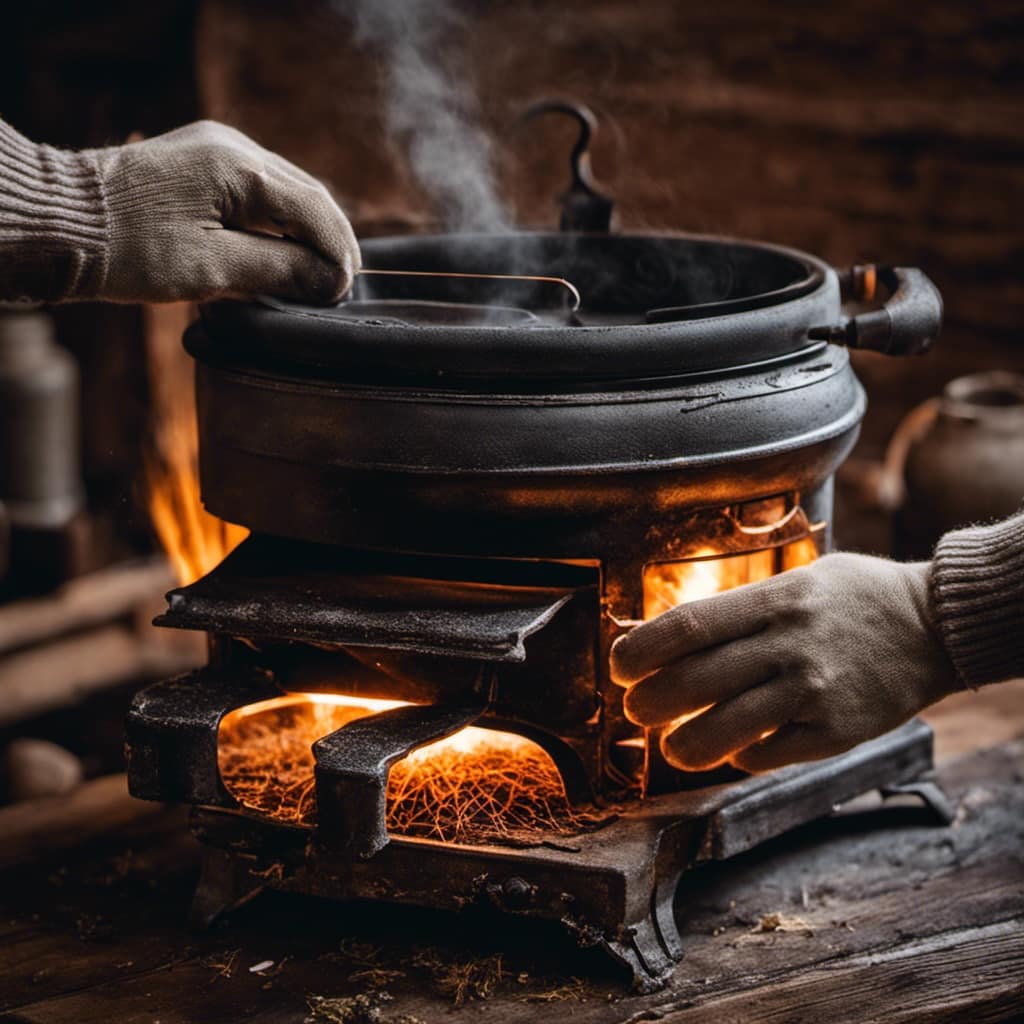
While rinsing off the cleaning solution, it’s important to inspect the glass for any remaining stains or spots. If you notice any stubborn residue, you may need to repeat the cleaning process or use a different cleaning solution specifically designed for removing tough stains on glass surfaces.
Once you’ve thoroughly rinsed off the cleaning solution and there are no visible streaks or residue on the glass, you can proceed to dry the glass door using a clean, dry cloth. This will give the glass a sparkling, streak-free finish, ready to be admired.
Dry the Glass Thoroughly
To ensure a sparkling, streak-free finish, I make sure to thoroughly dry the glass after rinsing off the cleaning solution. Drying the glass is just as important as cleaning it, as any remaining moisture can leave behind unsightly streaks. Over the years, I’ve developed a few drying techniques and polishing methods that guarantee a pristine glass surface every time.
Here are three effective ways to dry and polish your wood stove glass door:

-
Microfiber Cloth: Using a microfiber cloth is my go-to method for drying glass surfaces. These cloths are designed to absorb moisture and leave no lint or streaks behind. Gently wipe the glass in a circular motion until it’s completely dry.
-
Newspaper: Believe it or not, newspaper can be a great tool for drying glass. The ink acts as a mild abrasive, helping to remove any stubborn residue while leaving the glass streak-free. Simply crumple up a sheet of newspaper and use it to dry the glass in a circular motion.
-
Vinegar Solution: For an extra shine, I sometimes use a vinegar solution. Mix equal parts water and white vinegar in a spray bottle. Spray the solution onto the glass and wipe it dry with a microfiber cloth or newspaper. The vinegar helps to remove any remaining residue and leaves the glass sparkling clean.
Repeat the Cleaning Process as Needed
I find that repeating the process as needed ensures a consistently clean and clear surface. When it comes to cleaning the glass door of a wood stove, it’s important to establish a regular cleaning routine. The frequency of cleaning will depend on how often you use your wood stove and how quickly the glass becomes dirty. Personally, I clean the glass door of my wood stove every two weeks during the winter months, and once a month during the rest of the year.

To give you a better idea of the cleaning frequency, here’s a table that shows how often you should clean the glass door based on your usage:
| Usage | Cleaning Frequency |
|---|---|
| Daily | Every 2-3 days |
| Every 2-3 days | Weekly |
| Weekly | Every 2 weeks |
| Every 2 weeks | Monthly |
| Monthly | Every 2-3 months |
Frequently Asked Questions
How Often Should I Clean the Wood Stove Glass Door?
I clean my wood stove glass door regularly to maintain its clarity and efficiency.
It’s recommended to clean the glass door at least once a month or more frequently if you use the stove daily.
By doing so, you prevent the buildup of soot and creosote, which can reduce visibility and hinder the stove’s performance.
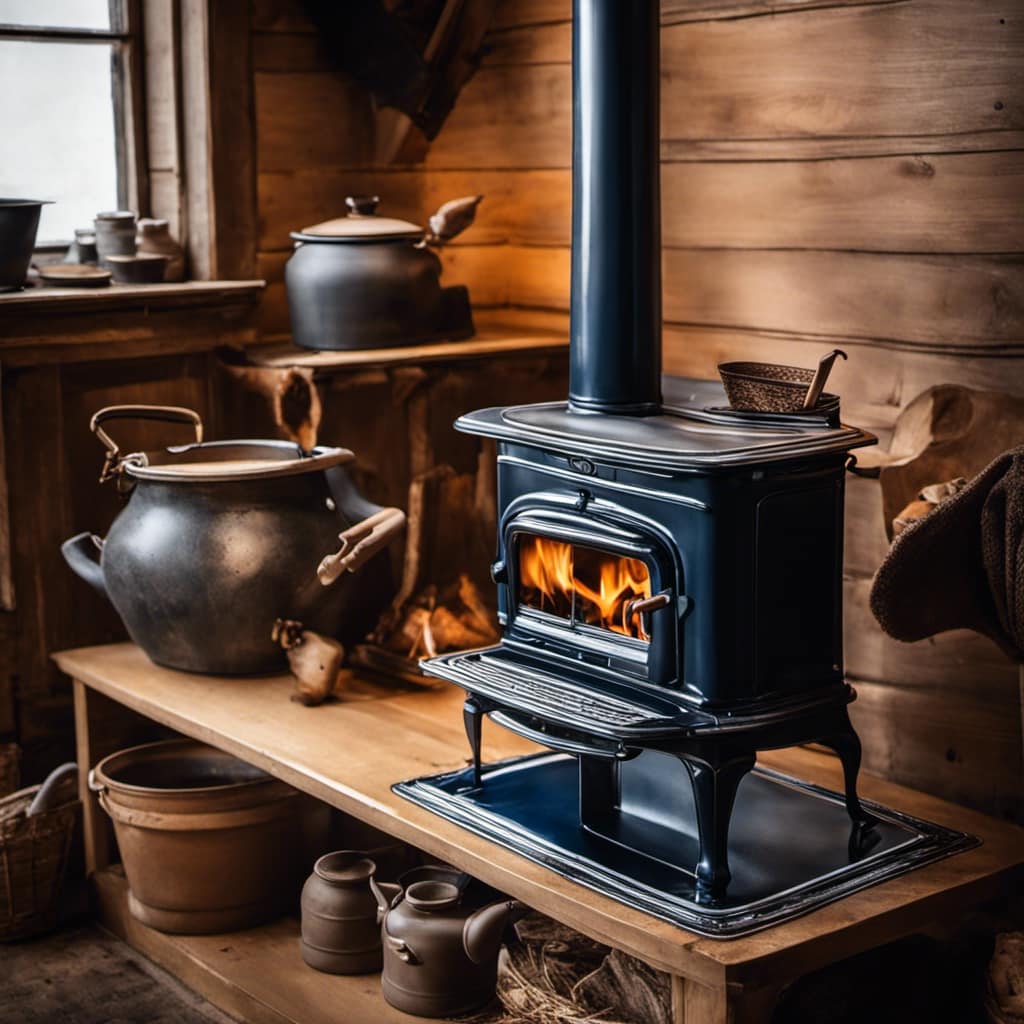
To clean effectively, use a mixture of vinegar and water or a specialized glass cleaner, and gently scrub with a non-abrasive cloth.
Can I Use a Regular Glass Cleaner to Clean the Wood Stove Glass Door?
I wouldn’t recommend using a regular glass cleaner to clean a wood stove glass door. It’s best to use cleaners specifically designed for this purpose, such as ones that are heat resistant and able to handle the soot and grime that accumulate on the glass.
There are also alternative cleaning methods, such as using vinegar or a paste made from baking soda and water, that can be effective in removing stubborn stains.
What Is the Best Kind of Brush or Sponge to Use for Scrubbing the Glass?
When it comes to cleaning the glass door of a wood stove, using the best cleaning tools is crucial. You want a brush or sponge that’s gentle yet effective at removing soot and grime. I’ve found that a soft-bristle brush or a non-abrasive sponge works wonders.
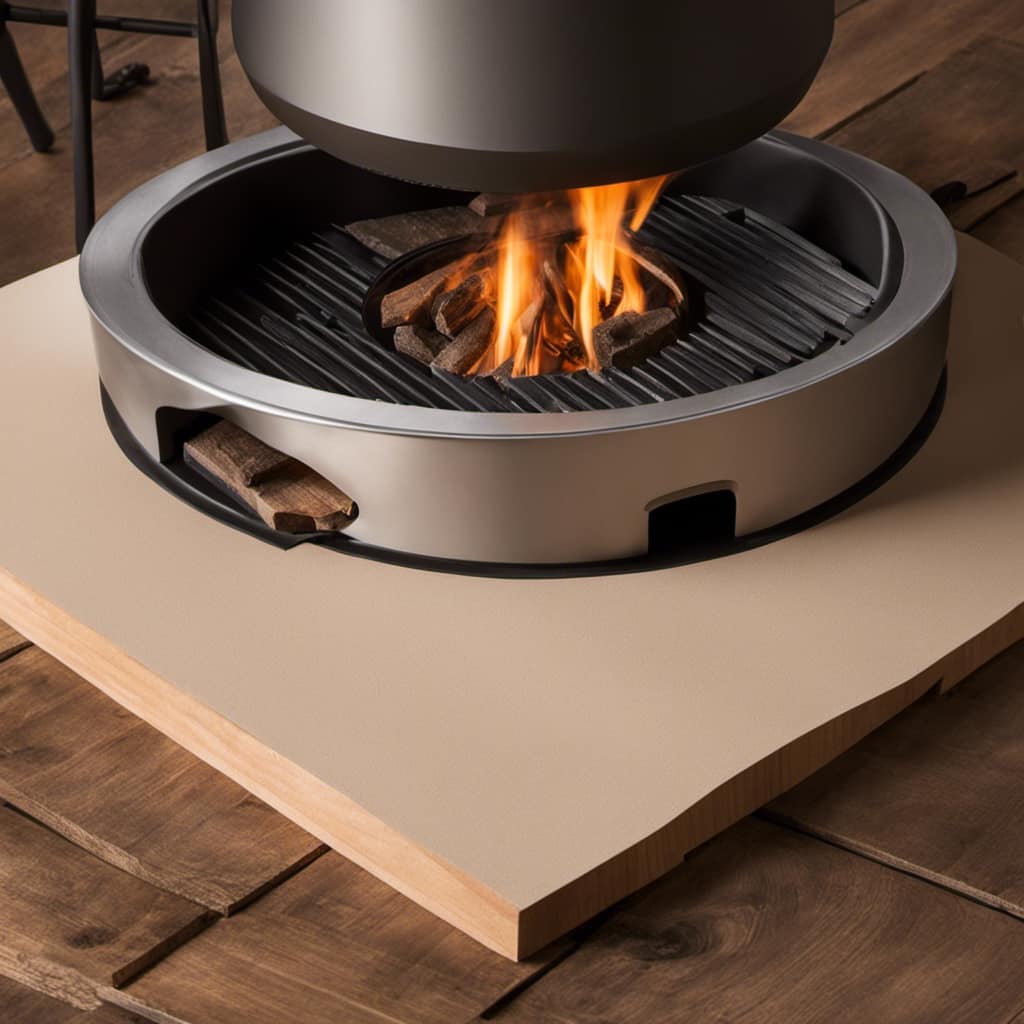
Additionally, alternative cleaning methods such as using a vinegar and water solution or a specialized glass cleaner specifically designed for wood stoves can also be effective. It’s all about finding what works best for you and your stove.
Should I Wear Gloves or Protective Gear While Cleaning the Glass Door?
Should I wear gloves or protective gear while cleaning the glass door?
When it comes to safety precautions, wearing gloves and protective gear is necessary. Cleaning a wood stove glass door can be a dirty and potentially hazardous task. Glass cleaners can contain harsh chemicals that may irritate the skin or eyes.
Wearing gloves and protective gear not only protects your hands and body, but also ensures that you can clean the glass door effectively without any discomfort or risk of injury.
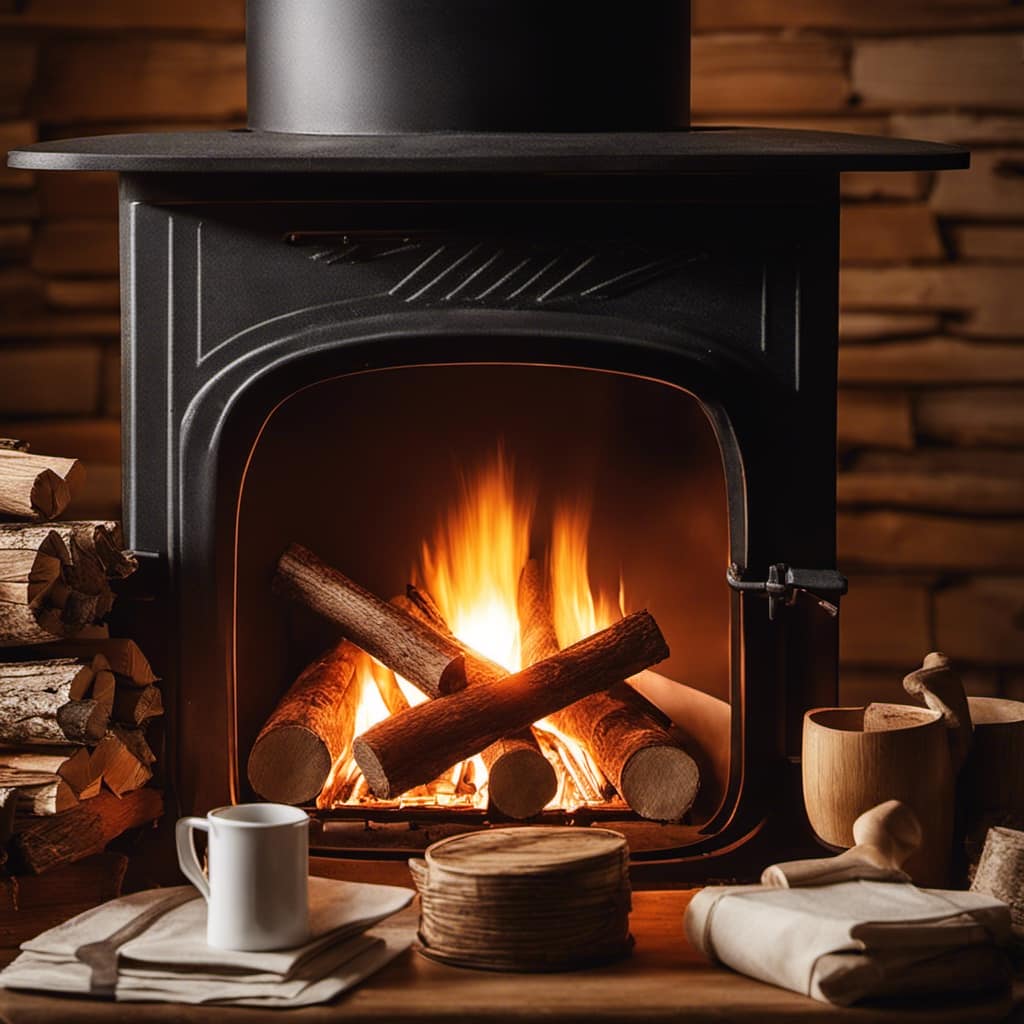
Are There Any Specific Safety Precautions I Should Take While Cleaning the Wood Stove Glass Door?
Safety measures and tips are essential when cleaning the wood stove glass door. It’s important to prioritize personal protection by wearing gloves and safety goggles.
Before starting, ensure that the stove is completely cool to avoid burns.
Use a non-abrasive cleaner specifically designed for glass surfaces. Avoid using harsh chemicals as they can damage the glass.
Clean the door gently using a soft cloth or sponge, and dry it thoroughly to prevent streaks or smudges.

Conclusion
Cleaning the glass door of a wood stove is a simple yet essential task to maintain its efficiency and appearance.
By following the outlined steps, you can easily remove ash and soot buildup, restoring the clear view of the fire.
For instance, Sarah, a wood stove owner, struggled with a heavily stained glass door. After applying the cleaning solution and gently scrubbing, she was amazed at how the glass sparkled, allowing her to enjoy the warm glow of the fire once again.
Growing up surrounded by the vast beauty of nature, Sierra was always drawn to the call of the wild. While others sought the comfort of the familiar, she ventured out, embracing the unpredictable and finding stories in the heartbeat of nature.
At the epicenter of every remarkable venture lies a dynamic team—a fusion of diverse talents, visions, and passions. The essence of Best Small Wood Stoves is crafted and refined by such a trio: Sierra, Logan, and Terra. Their collective expertise has transformed the platform into a leading authority on small wood stoves, radiating warmth and knowledge in equal measure.
Wood Stove
How Much Is Small Indoor Insulated Wood Stove
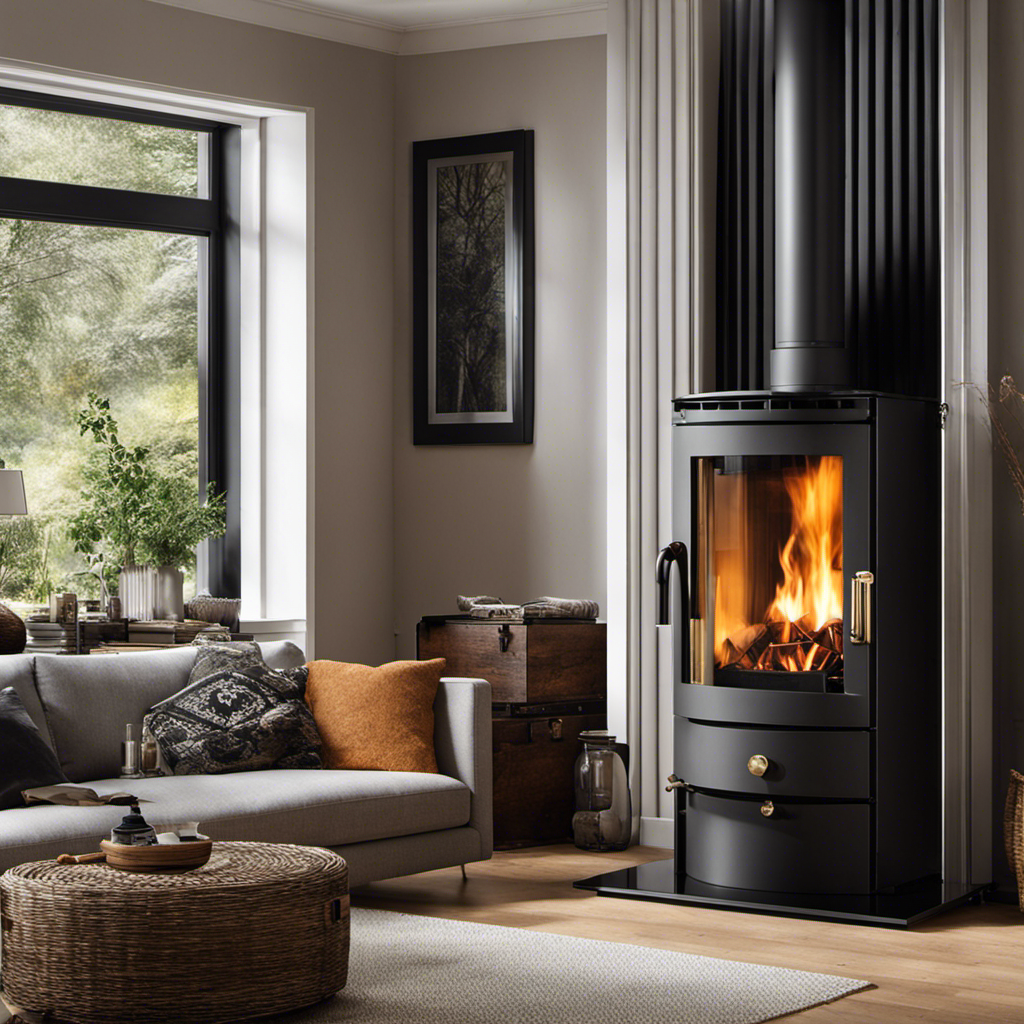
I have conducted thorough research and can verify that seeking the ideal compact, indoor insulated wood stove is indeed a challenging task. But do not worry, as I am here to help you navigate through this process.
In this article, we’ll delve into the factors that affect the cost, explore the price range of these stoves, compare different brands and models, and highlight additional expenses to consider.
Stick with me, and we’ll find the best deal on a small indoor insulated wood stove together.
Key Takeaways
- Factors affecting the cost and price range of small indoor insulated wood stoves include materials used, size of the stove, type of fuel required, and complexity of the stove’s design.
- When comparing costs of different brands and models, it is important to consider overall value for money, evaluate features and performance, and take into account customer reviews and ratings.
- Additional expenses to consider when buying a small indoor insulated wood stove include installation fees, ongoing maintenance costs, fuel expenses, and chimney cleaning requirements.
- To find the best deal on a small indoor insulated wood stove, it is recommended to research and compare prices, look for sales and discounts, consider purchasing used stoves in good condition, consult a professional for installation, and follow safety guidelines for maintenance and operation.
Factors Affecting the Cost of Small Indoor Insulated Wood Stoves
I can’t believe how much factors like materials and size affect the cost of small indoor insulated wood stoves. When it comes to installation requirements, the type of materials used can greatly impact the overall cost. For example, stoves made with high-quality materials, such as cast iron or stainless steel, tend to be more expensive than those made with lower-grade materials. Additionally, the size of the stove also plays a role in determining its cost. Larger stoves require more materials and labor for installation, thus driving up the price.
In terms of maintenance costs, it’s important to consider factors such as the type of fuel used and the complexity of the stove’s design. Stoves that require specialized fuel or have intricate components may require more frequent maintenance and therefore incur higher costs.
With these factors in mind, it’s clear that the cost of small indoor insulated wood stoves can vary significantly based on installation requirements and maintenance costs, making it crucial to consider these factors when making a purchase decision.
Now that we’ve discussed the factors affecting the cost of small indoor insulated wood stoves, let’s move on to the price range of these stoves.
Price Range of Small Indoor Insulated Wood Stoves
Typically, small indoor insulated wood stoves range in price from around $500 to $1500, depending on the brand and features. When considering the cost vs. efficiency of these stoves, it’s important to weigh the benefits they offer.
Here are three key benefits of small wood stoves:
-
Energy efficiency: Small wood stoves are designed to efficiently burn wood, resulting in a higher heat output compared to traditional fireplaces. This can lead to significant cost savings on heating bills.
-
Environmental friendliness: Wood is a renewable resource, making small wood stoves a more sustainable heating option. Additionally, modern wood stoves are designed to emit fewer pollutants, reducing their impact on air quality.
-
Ambiance and coziness: There’s something special about the crackling sound and warm glow of a wood fire. Small wood stoves provide a cozy and inviting atmosphere, creating a focal point in any room.
Considering the cost vs. efficiency and the numerous benefits they offer, small indoor insulated wood stoves are a worthwhile investment for those looking to add warmth and charm to their homes.
Comparing the Costs of Different Brands and Models
I’ve compared the costs of different brands and models, and found that there’s a wide range of prices available.
When comparing features, efficiency, and performance of small indoor insulated wood stoves, it’s important to consider the overall value for your money. Some brands may offer more advanced features, such as programmable thermostats or remote control operation, but these additional features often come with a higher price tag.
It’s also crucial to evaluate customer reviews and ratings to gauge the reliability and satisfaction of other users. By doing so, you can get a better understanding of the overall performance and durability of the stove.
It’s essential to strike a balance between cost, features, and customer satisfaction to ensure you make the right choice for your needs.
Additional Expenses to Consider When Buying a Small Indoor Insulated Wood Stove
When buying a small indoor insulated wood stove, it’s important to consider both the initial cost and the ongoing maintenance expenses. While the upfront price tag might seem daunting, it’s crucial to remember that there are additional expenses that can add up over time. Here are a few things to keep in mind:
-
Installation fees: Beyond the cost of the stove itself, you’ll need to factor in the cost of professional installation. This ensures that the stove is properly installed and meets all safety requirements, giving you peace of mind.
-
Maintenance costs: While wood stoves are generally low-maintenance, there are still some expenses to consider. This includes regular chimney cleaning, which helps prevent creosote buildup and ensures efficient operation. Additionally, you may need to replace gaskets or other components over time.
-
Fuel expenses: Wood stoves require a steady supply of firewood, which can be an ongoing cost. It’s important to factor in the price of firewood and ensure a reliable source.
Considering these additional expenses will help you make an informed decision and budget accordingly for your small indoor insulated wood stove.
Tips for Finding the Best Deal on a Small Indoor Insulated Wood Stove
I found an article with some great tips for finding the best deal on a small indoor insulated wood stove. It’s important to do your research and compare prices from different retailers to ensure you’re getting the best price. Additionally, consider looking for sales or discounts, especially during off-seasons when demand is lower. Another tip is to check for any used wood stoves in good condition, as they can be more affordable.
Here are some key factors to consider when purchasing a small indoor insulated wood stove:
| Factors to Consider | Tips |
|---|---|
| Installation | Consult a professional for proper installation to ensure safety and efficiency. |
| Maintenance | Regular cleaning and inspection are necessary to prevent creosote buildup and ensure optimal performance. |
| Safety Precautions | Follow safety guidelines such as using a fireproof hearth, keeping flammable items away, and using proper ventilation. |
| Heating Efficiency | Look for stoves with high efficiency ratings to maximize heat output and minimize fuel consumption. |
| Environmental Impact | Consider EPA-certified stoves that meet emission standards for cleaner burning and reduced pollution. |
Using a small indoor insulated wood stove for heating purposes has several advantages. It provides a cozy and efficient heat source, especially in colder climates. It can also save on energy costs compared to other heating options. Additionally, wood stoves offer a backup heat source during power outages. However, it’s important to follow proper installation, maintenance, and safety precautions to ensure safe and effective use.
Frequently Asked Questions
Are There Any Safety Regulations or Certifications That Small Indoor Insulated Wood Stoves Need to Meet?
Safety regulations and certifications for small indoor insulated wood stoves are essential to ensure the safety of users. These requirements help ensure that the stoves meet specific standards for materials, construction, emissions, and installation, promoting a safe and efficient heating experience.
What Are the Maintenance Requirements for a Small Indoor Insulated Wood Stove?
Maintenance requirements for a small indoor insulated wood stove include regular cleaning of the chimney and flue, removing ash and creosote buildup, and checking the insulation effectiveness. As they say, "An ounce of prevention is worth a pound of cure."
Can a Small Indoor Insulated Wood Stove Be Used as the Primary Heating Source for a Small Home?
Yes, a small indoor insulated wood stove can be used as the primary heating source for a small home. It offers numerous benefits such as cost-effectiveness, energy efficiency, and a cozy ambiance compared to other heating options.
How Long Does the Average Small Indoor Insulated Wood Stove Last Before Needing to Be Replaced?
The average small indoor insulated wood stove can last for several years before needing to be replaced. Replacement frequency depends on factors such as usage, maintenance, and quality of materials.
Are There Any Government Incentives or Tax Credits Available for Purchasing a Small Indoor Insulated Wood Stove?
There are government incentives and tax credits available for purchasing a small indoor insulated wood stove. These incentives can help offset the cost and make it more affordable for homeowners.
Is Black Glass on a Wood Stove Normal and Can It Be Prevented?
If you’re wondering about reasons for wood stove glass blackening, it is actually quite common and can be prevented with the right steps. The blackening occurs due to the buildup of soot and creosote, which form during combustion. Regular cleaning and proper burning techniques, including using the right fuel and maintaining adequate airflow, can help prevent the blackening of the glass on a wood stove.
Conclusion
After considering the factors affecting the cost, the price range of small indoor insulated wood stoves, comparing different brands and models, and the additional expenses to consider, it’s clear that finding the best deal on a small indoor insulated wood stove can be a complex task.
However, with careful research and attention to detail, one can find the perfect stove that not only fits their budget but also adds warmth and charm to their indoor space like a cozy embrace on a cold winter night.
Growing up surrounded by the vast beauty of nature, Sierra was always drawn to the call of the wild. While others sought the comfort of the familiar, she ventured out, embracing the unpredictable and finding stories in the heartbeat of nature.
At the epicenter of every remarkable venture lies a dynamic team—a fusion of diverse talents, visions, and passions. The essence of Best Small Wood Stoves is crafted and refined by such a trio: Sierra, Logan, and Terra. Their collective expertise has transformed the platform into a leading authority on small wood stoves, radiating warmth and knowledge in equal measure.
Wood Stove
What Is The Flue On A Wood Stove
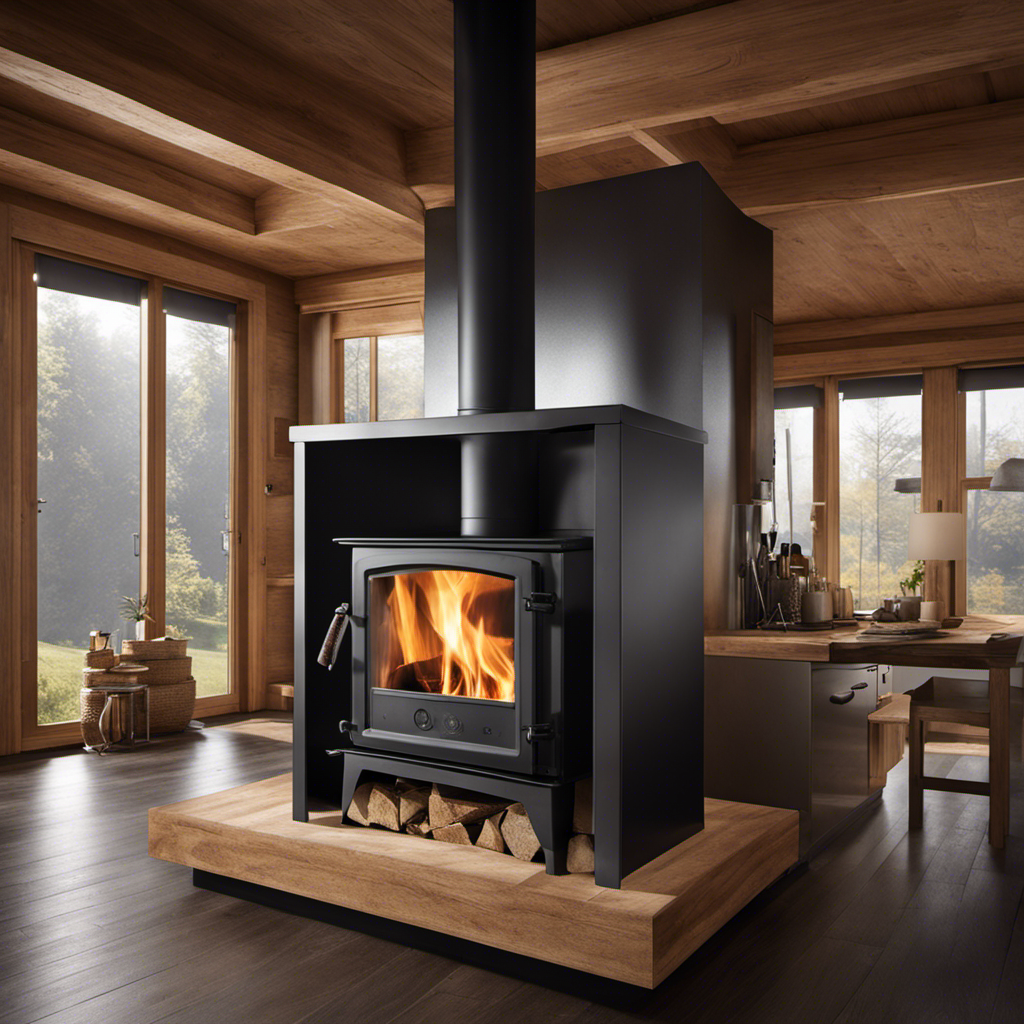
I must confess, the chimney of a wood stove is truly an intriguing component. It’s more than just a simple pipe sticking out, it plays a vital role in ensuring your wood stove operates at its best and most efficient.
In this article, we’ll delve into the ins and outs of wood stove flues, exploring their types, purpose, components, maintenance, and troubleshooting tips.
So buckle up and get ready to become a flue expert!
Key Takeaways
- The flue on a wood stove is a crucial component that expels harmful gases like carbon monoxide and allows for better airflow and combustion.
- It helps prevent creosote buildup, which can be a fire hazard.
- Using a chimney cap on the flue provides additional benefits by preventing rain, debris, and animals from entering the chimney.
- Regular maintenance, including inspection, cleaning, and clearing obstructions, is essential for safe operation of the wood stove flue.
Types of Flues Commonly Used on Wood Stoves
I’ve heard that there are various types of flues commonly used on wood stoves. When it comes to chimney installation, it’s important to consider the type of flue that will work best for your wood stove.
One option is a clay tile flue liner, which is a popular choice due to its durability and affordability.
Another option is a stainless steel flue liner, which offers increased strength and resistance to corrosion.
Additionally, there are cast-in-place flue liners, which are created by pouring a cement-like mixture into the chimney. These liners provide excellent insulation and can be custom-fit to your chimney.
Ultimately, the type of flue liner you choose will depend on factors such as your budget, the condition of your chimney, and your specific heating needs.
Transitioning into the next section, understanding the different types of flues is essential for grasping the purpose and functionality of a wood stove flue.
The Purpose and Functionality of a Wood Stove Flue
I understand the purpose and functionality of a wood stove flue, as it helps to safely direct the smoke and gases out of the house and into the outdoors. The importance of proper ventilation in wood stove flues can’t be overstated.
Here are four reasons why it’s crucial:
-
Safety: A well-ventilated flue ensures that harmful gases, like carbon monoxide, are efficiently expelled from the house, preventing potential health hazards.
-
Efficiency: Proper ventilation allows for better airflow, leading to more efficient combustion and heat production. This results in a more effective and cost-efficient heating system.
-
Preventing Creosote Buildup: Adequate ventilation helps to minimize the accumulation of creosote, a highly flammable substance that can lead to chimney fires.
-
Benefits of using a chimney cap on wood stove flues: A chimney cap serves as a protective barrier against rain, snow, and debris, preventing potential damage to the flue and ensuring optimal performance.
Key Components of a Wood Stove Flue System
While discussing the key components of a wood stove flue system, it’s important to consider factors such as the chimney liner, damper, and cap.
The flue installation plays a crucial role in the overall performance and safety of a wood stove. A properly designed flue ensures efficient combustion and effective removal of smoke and gases from the stove.
The chimney liner, usually made of stainless steel or clay tiles, protects the chimney walls from heat and corrosion.
The damper, located at the top of the flue, controls the airflow and helps regulate the temperature inside the stove.
Lastly, the cap prevents rain, debris, and animals from entering the flue.
A well-designed flue system, combined with proper maintenance and regular cleaning, ensures the safe and efficient operation of a wood stove.
How to Properly Maintain and Clean Your Wood Stove Flue
To ensure the safe and efficient operation of your wood stove, it’s crucial to know how to properly maintain and clean your wood stove flue. The flue is an essential component of your wood stove system that helps remove smoke and gases from your home.
Here are four important steps to properly maintain and clean your wood stove flue:
-
Regular Inspection: Inspect the flue for any signs of damage, such as cracks, loose bricks, or corrosion. These can affect the performance and safety of your wood stove.
-
Cleaning: Regularly remove creosote buildup from the flue using a chimney brush or hiring a professional chimney sweep. Creosote is highly flammable and can lead to chimney fires if not properly cleaned.
-
Clearing Obstructions: Ensure that the flue is clear of any debris, bird nests, or other obstructions that can block the airflow.
-
Professional Inspection: Schedule a professional inspection at least once a year to thoroughly examine the flue system and address any potential issues.
Common Issues and Troubleshooting Tips for Wood Stove Flues
One common issue with wood stove flues is the accumulation of creosote, which can be prevented by regular cleaning and maintenance. Creosote is a highly flammable substance that builds up inside the flue as a result of burning wood. If left untreated, it can lead to chimney fires and pose a serious safety hazard.
To prevent this, it’s important to have a proper wood stove flue installation and to be aware of the signs of a blocked wood stove flue. Signs of a blocked flue include smoke backing up into the room, difficulty in starting or maintaining a fire, and a strong odor of burnt wood or smoke throughout the house.
Regular cleaning and maintenance, such as removing creosote buildup and ensuring proper ventilation, are crucial for the safe and efficient operation of a wood stove.
Frequently Asked Questions
How Do I Choose the Right Size Flue for My Wood Stove?
To choose the right size flue for your wood stove, you’ll need to calculate the flue diameter based on the stove size. Larger stoves require larger flues to ensure proper ventilation and efficient operation.
Can I Install a Wood Stove Flue Myself, or Should I Hire a Professional?
Can I install a wood stove flue myself, or should I hire a professional? It’s crucial to prioritize safety, as common mistakes in wood stove flue installation can lead to fire hazards. Consulting a professional is wise.
Are There Any Safety Precautions I Should Take When Using a Wood Stove Flue?
When using a wood stove flue, it’s important to prioritize safety. Regular flue maintenance and cleaning flue residue are key. Taking precautions like using proper protective gear and ensuring proper ventilation can help prevent potential hazards.
Should I Leave the Flue Open or Closed When the Wood Stove Is Not in Use?
When the wood stove is not in use, it is important to keep the flue closed. This prevents drafts and heat loss, leading to better energy efficiency. Opening the flue can result in wasted energy.
Can I Use the Same Flue for Multiple Wood Stoves in Different Rooms?
Yes, you can use the same flue for multiple wood stoves in different rooms. However, it’s important to choose the right flue materials and maintain cleanliness to ensure proper ventilation and prevent any safety hazards.
How Does the Flue Connect to the Franklin Wood Stove?
The connecting franklin wood stove offers a practical solution for ensuring proper ventilation and efficient heat distribution. By connecting the flue to the Franklin wood stove, it effectively channels the smoke and gases out of the room, while also allowing fresh air to enter. This connection plays a crucial role in maintaining a safe and cozy environment during cold winter nights.
Conclusion
In conclusion, the flue on a wood stove is a crucial component that ensures the safe and efficient operation of the stove. It acts as a chimney, allowing smoke and gases to escape while preventing drafts and keeping the heat inside.
Proper maintenance and regular cleaning of the flue are essential to avoid issues such as creosote buildup and chimney fires. By taking care of your wood stove flue, you can enjoy cozy and worry-free fires all winter long, creating a warm and inviting atmosphere in your home.
Growing up surrounded by the vast beauty of nature, Sierra was always drawn to the call of the wild. While others sought the comfort of the familiar, she ventured out, embracing the unpredictable and finding stories in the heartbeat of nature.
At the epicenter of every remarkable venture lies a dynamic team—a fusion of diverse talents, visions, and passions. The essence of Best Small Wood Stoves is crafted and refined by such a trio: Sierra, Logan, and Terra. Their collective expertise has transformed the platform into a leading authority on small wood stoves, radiating warmth and knowledge in equal measure.
Wood Stove
How To Put Together The Exhaust Pipe Of A Wood Stove
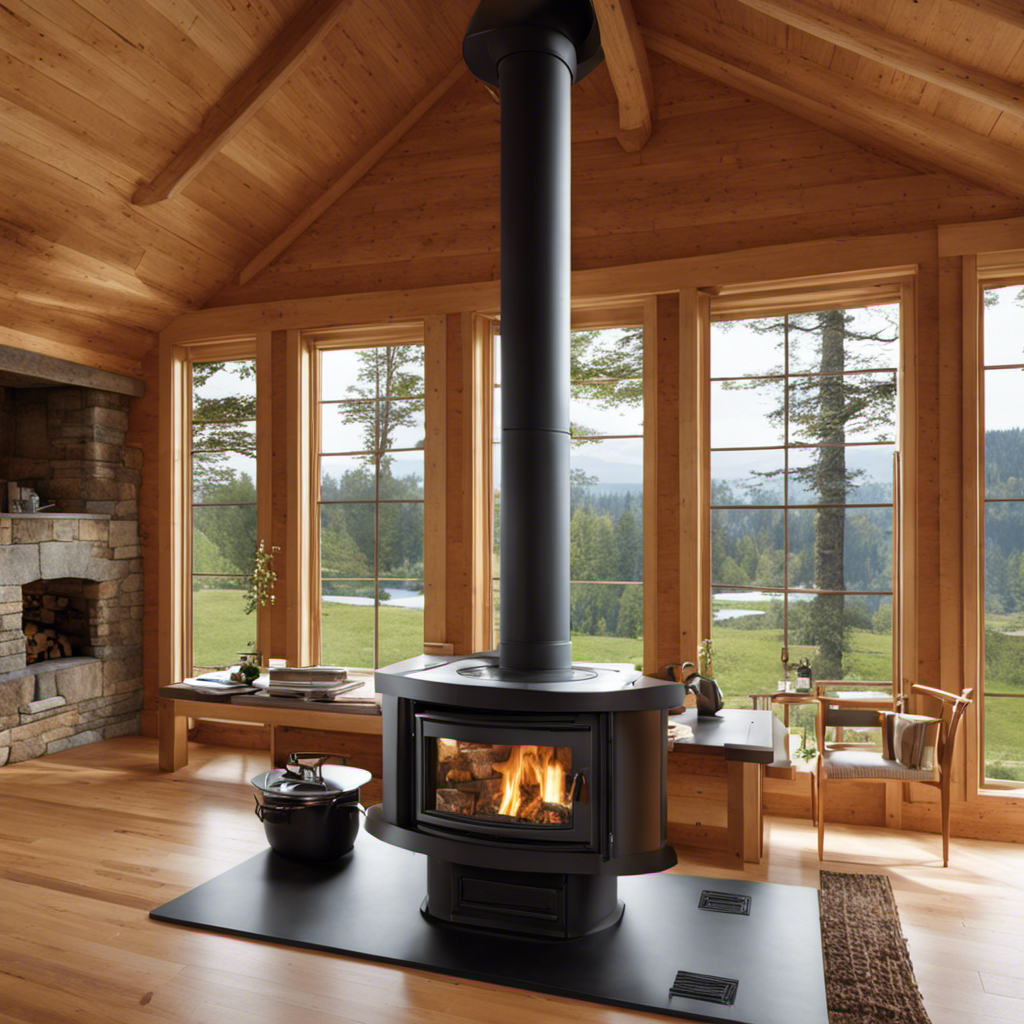
I’ve always treasured the cozy hug of a wood-burning stove on a cold winter evening.
But when it came time to put together the exhaust pipe, I felt a bit overwhelmed. How do all these components fit together?
Well, fear not! In this article, I’ll walk you through the step-by-step process of assembling the exhaust pipe for your wood stove.
With a few tools and some patience, you’ll be enjoying that toasty fire in no time.
Key Takeaways
- Properly attach the flange, position the muffler, and align the tailpipe for correct installation of the exhaust pipe
- Gather the right size and length of stainless steel pipes, elbows, and adapters for durability and resistance to high temperatures
- Follow manufacturer’s guidelines and local building codes for preparing the wood stove and avoiding improper sizing or obstructions in the exhaust pipe
- Connect and secure the exhaust pipe sections using high-temperature silicone sealant, twist-lock or slip-fit joints, and install a chimney cap for proper ventilation and maintenance of airflow
Understanding the Exhaust Pipe Components
I have learned about the three main components of an exhaust pipe: the flange, the muffler, and the tailpipe.
The flange is a flat, circular metal piece that connects the exhaust pipe to the wood stove. It provides a secure attachment point and ensures a proper seal.
The muffler is a cylindrical chamber that’s designed to reduce noise produced by the wood stove. It contains sound-absorbing materials and is attached to the flange.
The tailpipe is the section of the exhaust pipe that extends outside the wood stove. It allows the combustion gases to vent out of the room.
Proper installation techniques for the exhaust pipe involve securely attaching the flange, positioning the muffler correctly, and ensuring that the tailpipe is properly aligned.
Regular maintenance of the wood stove exhaust pipe includes cleaning out any debris or soot buildup and checking for any signs of damage or leaks.
Gathering the Necessary Tools and Materials
After carefully reviewing the instructions, I’m ready to start gathering the necessary tools and materials for assembling the exhaust pipe.
The first step is to choose the right size and length of the pipe. It’s crucial to ensure that the diameter of the exhaust pipe matches the outlet of the wood stove. This ensures proper airflow and efficiency. Additionally, the length of the pipe should be determined based on the distance between the stove and the exterior wall or chimney. It’s important to maintain proper ventilation and clearance for the wood stove.
Next, I’ll gather the necessary materials, such as stainless steel pipes, elbows, and adapters. These materials are durable and resistant to high temperatures.
With the right tools and materials in hand, I can now proceed with the assembly process.
Preparing the Wood Stove for Installation
Before starting the installation process, I need to ensure that the wood stove is properly prepared and ready for installation. The importance of proper ventilation for wood stoves can’t be overstated. Without proper ventilation, the wood stove can produce harmful gases, such as carbon monoxide, which can be extremely dangerous.
To ensure proper ventilation, it’s crucial to follow the manufacturer’s guidelines and local building codes. One common mistake to avoid when installing a wood stove exhaust pipe is improper sizing. The exhaust pipe should be the correct diameter and length to provide adequate airflow and prevent backdraft. Additionally, it’s important to avoid sharp bends or obstructions in the exhaust pipe, as this can restrict airflow and reduce the stove’s efficiency.
Connecting and Securing the Exhaust Pipe Sections
To properly install the wood stove, it’s essential to connect and secure the exhaust pipe sections using the manufacturer’s recommended methods. This ensures a safe and efficient operation of the stove.
Begin by attaching the first section of the exhaust pipe to the flue collar on the stove. Use high-temperature silicone sealant to create an airtight connection.
Then, connect additional sections of the pipe using twist-lock or slip-fit joints, making sure to align the seams properly. Once the pipe is assembled, install the chimney cap to prevent debris and animals from entering.
It’s crucial to maintain proper airflow throughout the exhaust system to avoid backdrafts and ensure optimal performance. Regularly inspect and clean the pipe for any obstructions or creosote buildup.
By following these steps, you can successfully connect and secure the exhaust pipe sections for your wood stove.
Now, let’s move on to testing and troubleshooting the exhaust pipe assembly.
Testing and Troubleshooting the Exhaust Pipe Assembly
I need to test the exhaust pipe assembly for any leaks, so I’ll check all the connections and use a smoke test to ensure everything is sealed properly.
Here are some troubleshooting techniques and common installation mistakes to be aware of:
-
Improper connection: One of the most common mistakes isn’t properly connecting the exhaust pipe sections. This can lead to leaks and inefficient operation of the wood stove.
-
Loose fittings: Another issue is having loose fittings. It’s crucial to ensure that all the connections are tight and secure to prevent any air or smoke leakage.
-
Faulty gaskets: Faulty gaskets can also cause leaks. It’s important to inspect the gaskets and replace them if necessary.
Frequently Asked Questions
How Often Should the Exhaust Pipe of a Wood Stove Be Cleaned?
Cleaning the exhaust pipe of a wood stove is important for proper functioning and safety. It should be done regularly to prevent creosote buildup and reduce the risk of chimney fires.
Can I Use a Different Type of Pipe for the Wood Stove Exhaust?
Yes, you can use a different type of pipe for the wood stove exhaust. It is important to choose alternative pipe materials that are compatible with your specific stove model for proper ventilation and safety.
What Are the Potential Hazards of a Poorly Installed or Damaged Exhaust Pipe?
The potential dangers of a poorly installed or damaged exhaust pipe for a wood stove cannot be underestimated. Proper installation is of utmost importance to prevent hazards such as carbon monoxide poisoning and potential fire outbreaks.
Is It Necessary to Use High-Temperature Sealant When Connecting the Exhaust Pipe Sections?
Using high-temperature sealant when connecting wood stove exhaust pipe sections provides a secure and airtight connection, preventing leaks and improving efficiency. Alternatives like gaskets or tape may not provide the same level of durability and reliability.
How Can I Determine if There Is an Obstruction or Blockage in the Exhaust Pipe?
To troubleshoot exhaust pipe blockages, I check for signs of a blocked exhaust pipe. These signs include reduced airflow, smoke or fumes backing up into the room, and excessive soot or creosote buildup.
Conclusion
In conclusion, assembling the exhaust pipe of a wood stove is like connecting the limbs of a sturdy tree, ensuring a seamless flow of warmth and comfort.
Following the precise steps and using the necessary tools and materials, you can create a secure and efficient exhaust pipe assembly for your wood stove.
Remember to test and troubleshoot the system to ensure optimal performance and a cozy, crackling fire for many winters to come.
-

 Wood Stove3 months ago
Wood Stove3 months agoHow To Build A Thermoelectric Generator For A Wood Stove
-

 Wood Stove4 months ago
Wood Stove4 months agoHow To Use Damper And Draft On Wood Stove
-

 Wood Stove4 months ago
Wood Stove4 months agoWhen To Open And Close Damper On Wood Stove
-

 Wood Stove4 months ago
Wood Stove4 months agoHow Far Does Wood Stove Have To Be From Wall
-

 Wood Stove3 months ago
Wood Stove3 months agoHow Does A Circulator Wood Stove Work
-

 Pellet Stoves3 months ago
Pellet Stoves3 months agoWhy Is My Wood Pellet Stove Putting so Much Soot
-

 Wood Stove4 months ago
Wood Stove4 months agoWhat Can I Use As Insulation On Wood Stove Pipes
-

 Pellet Stoves3 months ago
Pellet Stoves3 months agoHow to Make a Pellet Basket for Wood Burning Stoves











